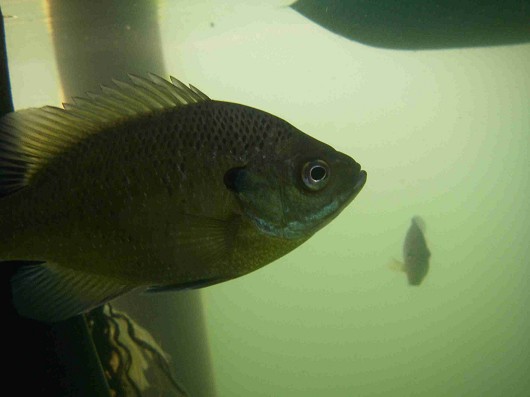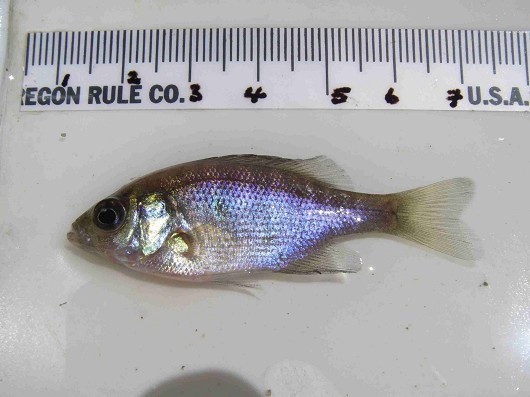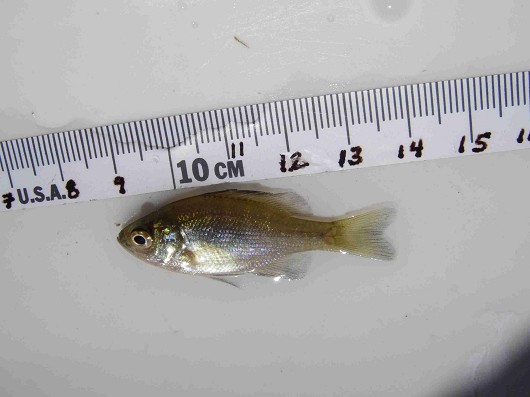Bluegill
-
Scientific NameLepomis macrochirus
-
NativeNon-Native
-
Identification
 Bluegill approximately 15 cm (6”) long. Location: Leonard Lake, California Date: 8/6/2008 Photo: Lisa Thompson
Bluegill approximately 15 cm (6”) long. Location: Leonard Lake, California Date: 8/6/2008 Photo: Lisa Thompson Bluegill with measurements Location: Leonard Lake, California Date: 8/6/2008 Photo: Lisa Thompson
Bluegill with measurements Location: Leonard Lake, California Date: 8/6/2008 Photo: Lisa Thompson Bluegill with measurements. Location: Leonard Lake, California Date: 8/6/2008
Bluegill with measurements. Location: Leonard Lake, California Date: 8/6/2008- Deep, compressed body
- Flexible blue or black flap on the rear of each operculum
- Long pointed pectoral fins
- Black spot on the rear of the dorsal fin
- Narrow vertical black bars on the side
- 11-12 anal, 13-14 pectoral, 10-12 dorsal, and 5 pelvic rays
- 3 anal and 10 dorsal spines
- 38-48 scales on the lateral line
- Iridescent purple shine
- Breeding males turn dark olive to bronze on their backs and sides, orange on their breast, iridescent black on the pelvic and anal fins, while a dark spot develops on the soft portion of the dorsal fin
-
Life History
Bluegills are most common in warm, shallow lakes, reservoirs, ponds, streams, and sloughs at low elevations. They can also be found in streams if there are deep, well covered and vegetated pools and warm summer temperatures. These populations will avoid the dangers of high flow by moving into backwaters or flooded regions. In all areas they prefer temperatures between 27°C and 32°C but can live in waters as cold as 2-5°C and as warm as 40-41°C. They are more limited by salinity levels however, occasionally being found in areas of 5 ppt but suffering from arrested development at 8 ppt and dying at 12 ppt. They grow best in areas with dissolved oxygen levels between 4 mg/L and 8 mg/L but can survive in levels less than 1 mg/L. Inside lakes and reservoirs bluegills are most often found among aquatic plants growing out of silt, sand, or gravel usually no deeper than 5 m. They are a highly opportunistic species, maneuverable enough to feed from the bottom, on vegetation, or in midwater. Aquatic insect larvae are preferred food but planktonic crustaceans, flying insects, and snails are common food items and small fish, fish eggs, and crayfish can be taken when available. This variety of options leads to a diversity in diets between populations that can vary dramatically depending on their location. Algae and aquatic vegetation can be used when other food is scarce but a consistent diet of this material will stunt growth. Bluegills will usually stay in one restricted area for most of their lives, due largely to their long breeding season. This lack of movement brings with it a great deal of knowledge of the area, however, and allows the bluegills to comfortably pick other fish clean of parasites and loose tissue, an activity unlikely to occur if the bluegill was not aware of the area’s potential predators.
Spawning occurs in summer when temperatures reach 18-21°C and may continue through to September. Bluegills, like many sunfish, have a variety of male mating strategies. The most straightforward and common type is known as a parental male. These males make up approximately 70% of the population and tend to be the largest males in area. They construct 20-30 cm wide and 5-15 cm deep nests out of the gravel, sand, or mud substrate in shallow water. Different males' nests will be built close to each other forming a protective colony but each nest is also intensely defended from the other males in the colony. The stronger males take advantage of this, controlling the central nests of the colony where lines of other males act as a protective wall against outside predators. While the nests are being constructed, females swim in schools around the nesting area until one is ready to mate. At this point a female will leave the school and swim toward the nests where she is courted by the dominant male in the immediate vicinity. They then swim together to the male’s nest where the female drops her eggs and the male fertilizes them. The eggs stick to debris on the bottom of the nest and stay there until they hatch. This will be repeated many times for both sexes resulting in as many as 62,000 eggs in one nest although 2,000-18,000 is more common. Each female will release between 2,000 and 50,000 eggs. Mating will also happen in a very short window of time so that the entire colony births in one large movement reducing the impacts of predation. The young are also protected by the parental males that will guard the nest and young for days after they hatch. In contrast the satellite and sneaker male mating types have no such obligation. Satellite males mimic females in size, coloration, and behavior in order to follow a mating parental pair into the nest and fertilize some of the dropped eggs. The sneaker male is less subtle and will instead wait at the edge of a colony before racing inside to spawn beside a mating parental couple. The parental male may make attempts to chase these groups away but often times this only allows a satellite male to fertilize all of a female’s eggs. While these alternate strategies may have the advantage of forcing the caretaker role on another, satellite and sneaker males are so battered by fights and chases that by the end of the spawning season they will often be in a greatly weakened state. Regardless of strategy the eggs will hatch 2-3 days later in 20°C water and the breeding cycle starts again a week later. The newly hatched young travel from the nest to beds of plants where they will stay except for a 6-7 week period when they are between 10 mm and 25 mm long in which they enter the water column and feed on plankton. In their first year they will grow to 4-6 cm and will add 2-5 cm each following year. Few individuals live longer than 6 years.
-
Links to Other ResearchN / A
-
WatershedN / A
Please note, watersheds are at the USGS 8-digit Hydrologic Unit Code (HUC) scale, so they often include a lot of sub-watersheds. If a species occurs in any sub-watershed within the HUC, the species appears within the HUC. Link to an EPA page that shows HUCs.


